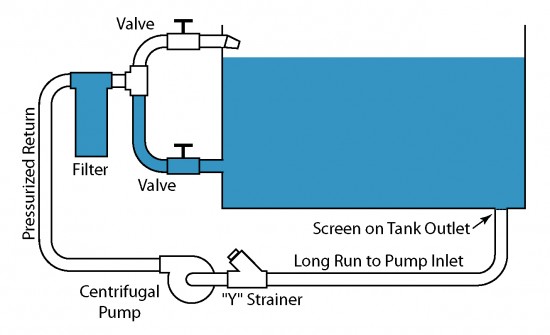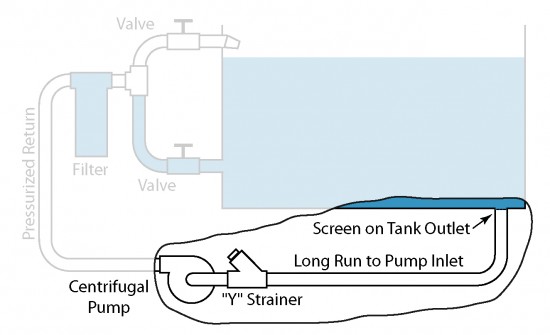Let’s again look at the system schematic shown in the preceding blog. This time, however, it is shown with an “air lock.”

The centrifugal pump, unable to pump air, is not able to move liquid to replace the air trapped in the plumbing system. At first glance, it may not be obvious how this condition can exist. After all, the pump is below the tank, there’s no apparent obstruction between the tank and the pump – it seems that the liquid should flow easily to the pump and the rest of the plumbing. The “trouble,” in fact is air! Today’s focus will be causes for air entrapment on the inlet side of the pump.

Before liquid can fill the plumbing, the trapped air must be released or removed. Since the pump is located below the tank, one might expect that the air would bubble back into the tank allowing the line feeding the pump to fill with liquid and all would be well. Although it is a logical assumption, there are several obstacles that need to be overcome for this to happen. The first, and most surprising, is a screen or strainer on the outlet of the tank.
Note – A screen or strainer is often provided on the outlet of a cleaning tank to protect the pump from small parts inadvertently entering the tank outlet. A “Y” strainer in the line leading from the tank to the pump produces much the same effect as described below.
In fact, a screen or strainer would easily let liquid pass if there were no pressure below it. If air is trapped under the strainer, however, the surface tension of the liquid prevents the air from rising up through the strainer to let the liquid pass through. This effect is more likely if the diameter of the tank outlet is small and/or if the liquid is de-ionized water. A “Y” strainer can also act as an obstacle to air movement. Although the buoyancy of air alone can be sufficient to hold back a considerable amount of liquid, air trapped without an alternative exit may also provide considerable pressure further complicating the problem.
Another possible and less obvious problem with the theory that trapped air will bubble back up into the tank is the angle of the feed line going from the tank outlet to the pump. If this pipe is not level or angled up from the pump, air will be trapped. Just as water won’t flow uphill on its own, air will not flow downhill on its own and remains trapped at the high point. Elbows, T’s, valves and other plumbing features in the feed line to the pump all contribute to the difficulty of the path that air must take to exit the plumbing.
After reading the above, you might wonder why the trapped air doesn’t just go out the other way – – That’s a topic for the next blog!
– FJF –



 English
English Spanish
Spanish Chinese
Chinese Canada
Canada Mexico
Mexico United Kingdom
United Kingdom



